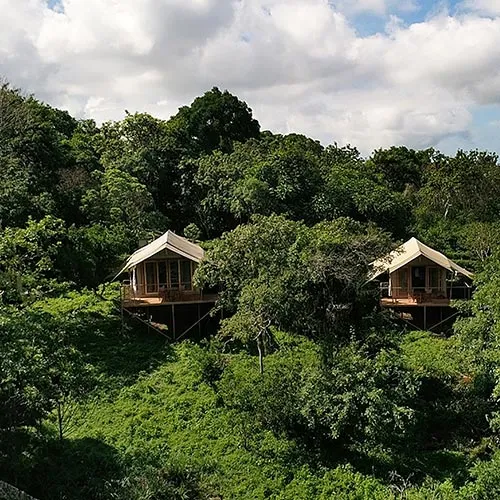There are 25 native reptile species in the Galapagos, 19 of which are endemic. Millions of years ago their ancestors were washed off the mainland and carried to the Galapagos on pieces of driftwood. Upon arrival they adapted to their new environment and evolved in remarkable ways. The following are three examples of reptiles that helped plant that light bulb in Darwin’s head.
The Marine Iguana
In The Voyage of the Beagle, Charles Darwin describes the Marine Iguana as ‘a hideous-looking creature, of a dirty black colour, stupid and sluggish in its movements’. It’s true, they may not be the most beautiful of animals but they are excellent examples of Darwin’s evolution theory. Unlike their mainland-dwelling counterparts that live in trees and eat fruits, the marine iguana is amphibious and feeds off green (but not brown!) algae, seaweed and small crustaceans in the sea. They can swim to depths of 15 metres (50 feet) and can stay underwater for up to an hour. When underwater their body temperatures can drop as much as 20°F (6°C) which is why you often finding them basking in the sun after a swim. Their dark colour helps them absorb heat more quickly and they are able to expel any salt ingested underwater through glands near their noses.
Swimming Marine Iguanas
Credit:BBC Earth
The Marine Iguana can only be found in the Galapagos Islands and can be seen at any time of year. The best islands to find them on are Genovese, Isabela and Fernandina. The latter island, Fernandina, is where the BBC filmed that incredible scene of a baby marine iguana narrowly escaping a pit of racer snakes. The video clip that went viral and eventually won them a Bafta for Must-See Moment.
The BBC Blue Planet Marina Iguana ‘Must-See Moment’
Credit:BBC Earth
Facts about the Marine Iguana
- Breeding season: December to March
- Nesting season: January to April
- Life expectancy: 5-12 years
- Size: 4-5 feet
The Land Iguana
It’s thought that there are between 5000-10,000 land iguanas in Galapagos today. They are usually found living in small colonies in the drier parts of the archipelago where they can feed on low-lying, and often prickly vegetation such as cacti.
Land Iguanas sleep in shallow underground burrows that they stay close to day and night. In The Voyage of the Beagle, Charles Darwin wrote, “…when we were left at James Island, we could not for some time find a spot free from their burrows on which to pitch our single tent. Like their brothers the sea-kind, they are ugly animals, of a yellowish orange beneath, and of a brownish red colour above: from their low facial angle they have a singularly stupid appearance.”
There are three species of Land Iguana:
- The Conolophus subcristatus: these are yellowish in colour and can be found on Fernandina, Isabela, Santa Cruz, Seymour, and South Plaza islands.
- The Conolophus pallidus: these are yellow to white in colour, with brown patches. They can only be found on Santa Fe. Pale
- The Conolophus marthae: Also known as the Rosado (‘pink’) Iguana, these are the most threatened species of Land Iguanas and can only be found in the highlands of Isabela Island, around Wolf Volcano.
Pink Iguana discovery
Credit: BBC
Both Marine Iguanas and Land Iguanas inhabit South Plaza Island, and often hybrids can be found there.
Facts about the Land Iguana
- Length: 3+ feet long
- Weight: 13kg / 30lb
- Sexual maturity: 6-10 years.
- Mating Season: Dec-May
- Nesting Season: January – March
- Incubation period: 90-125 days
- Life expectancy: 50-60 years
The Giant Tortoise
The most iconic reptile of the Galapagos is the Giant Tortoise. According to folklore, the name Galapagos is derived from the old Spanish word, galápago, meaning tortoise or a type of saddle resembling a tortoise’s shell.
Scientists believe that the tortoise drifted to the Galapagos Islands two to three million years ago and evolved into several sub-species, each unique to a specific island. The Pinta Island tortoise (C.abingdonii) is one such example. Unfortunately, however, the introduction of goats in the ‘50s destroyed much of the island’s vegetation and as a result, wiped out this particular species. The last living individual died in June 2012. Aptly named ‘Lonesome George’, he can now be found on display at the Charles Darwin Research Station.
Today, an estimated 20,000 to 25,000 wild tortoises roam the Galapagos Islands. One of the best places to find Giant Tortoises is in the Tortoise Reserve next to the Galapagos Safari Camp on Santa Cruz Island, or even within the camp itself. It’s not uncommon to find these gentle creatures chomping on grass beneath the tents. Wild tortoises can also be seen on San Cristóbal and Isabela.
In addition to the Galapagos, the Giant Tortoise can also be found in the Seychelles and the Mascarene Islands.
Facts about the Galapagos Giant Tortoise:
- Sexual Maturity: 20-25 years
- Mating Season: Usually during the hot season (January – May)
- Nesting Season: Usually during the cool season (June – December)
- Incubation: 110-175 days.
- Life expectancy: 100+ years. Scientists estimated that ‘Harriet’ – a Galapagos tortoise in an Australia Zoo – was between 169 and 175 years old when she died in 2006.
- Weight: 475lb / 200kg
- Mutualism: Giant tortoises have a symbiotic relationship with the Darwin Finch. The tortoise invites the Darwin Finch to pick off parasites from its shell by stretching its neck high up into the air. This allows the finch to access parts of its body that would be otherwise difficult to get to. If you see finches hopping on the ground in front of a tortoise this is a sign that the bird is ready to eat.
- For Kids: National Geographic Kids has as fun fact sheet here.
Plan your Galapagos Vacation
See our Safari Holidays for our suggested Galapagos itineraries and recommended activities.
